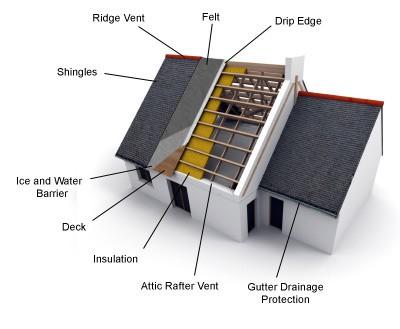Roof shingles play a crucial role in protecting our homes from the elements. Over time, shingles may wear out or sustain damage, leading homeowners to consider installing new shingles. However, a common question arises: How many layers of roof shingles are allowed? In this article, we’ll explore the answer to this question, the potential risks of multiple layers, and important considerations when deciding whether to add new shingles over existing ones.

Understanding the Concept of Layering Shingles
Layering shingles, also known as “roofing over,” involves installing new shingles directly over existing ones rather than removing the old shingles first. While it might seem like a convenient solution, there are several factors to consider before deciding to layer shingles.
The Number of Layers Allowed
The number of layers of shingles allowed varies based on building codes and regulations in your area. In many regions, two layers of shingles are permitted. However, it’s essential to check with your local building authority to confirm the specific regulations that apply to your location.
Considerations When Layering Shingles
Before deciding to layer shingles, consider the following factors:
- Weight: Each layer of shingles adds weight to the roof. Multiple layers can strain the structural integrity of the roof framing and may exceed weight limits.
- Aesthetics: Layered shingles can result in a less aesthetically pleasing appearance, as the edges of the new shingles may be visible, especially as they age.
- Ventilation: Layering shingles can impede proper ventilation, which is essential for maintaining a healthy roof and preventing moisture-related issues.
- Durability: New shingles applied over old ones may not adhere as well and could compromise the overall durability of the roof.
- Roof Warranty: Some roofing manufacturers’ warranties may be voided if new shingles are layered over old ones. It’s important to consider the impact on your warranty coverage.
When to Remove Existing Shingles
In some cases, it’s advisable to remove the existing shingles before installing new ones:
- If the existing shingles are severely damaged, warped, or curled.
- If you’re experiencing leaks or moisture-related issues, which may require a thorough inspection of the roof deck.
- If the roof has exceeded the allowable number of layers based on local building codes.
Seeking Professional Advice
Deciding whether to layer shingles or remove them requires careful consideration. It’s recommended to consult with a professional roofing contractor to assess the condition of your roof, provide expert advice, and help you make an informed decision based on your specific situation.
Conclusion
In conclusion, the number of layers of roof shingles allowed varies based on local building codes, with many areas permitting up to two layers. However, layering shingles comes with considerations such as weight, aesthetics, ventilation, and durability. It’s crucial to assess the condition of your existing shingles and consult with a professional roofing contractor before deciding whether to layer new shingles over old ones. By making an informed decision, you can ensure the longevity, safety, and performance of your roof while adhering to building regulations.



Leave a Reply